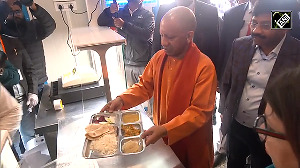Internationally acclaimed artist of Indian origin, Anish Kapoor is a sculptor. Kapoor's solo show this summer in London at the Lisson Gallery showed large stainless steel dishes mounted on the wall, selling comfortably for around £250,000 or about Rs 2 crore.
Strangely enough, the most well-known Indian artist residing in his native land, G Ravinder Reddy, too is a sculptor. Although not quite in the same league as Kapoor, Reddy is the only Indian artist to show at the highly reputed mainstream international gallery Dietch Projects in New York.
It seems quite strange that though India has an unusually rich tradition of sculpture, both classical and contemporary, this medium has been completely ignored even by the savviest of collectors.
Sculpture, unlike other mediums such as photography, video art and installations, is considered a basic mainstream form of expression the world over, similar to paintings. Why is it then that this medium remains in constant neglect and who is really to blame for it?
It might be correct to say that when art prices were abysmally low many artists chose to paint rather than sculpt merely because the cost of execution of the former was much lower, thereby reducing the proportion of sculptors to painters.
Although artist such as D P Roy Chowdhury and Ramkinkar Baij were sought after their death, there was really no superstar sculptor to match the charisma of Husain or even Souza. Twentieth century Indian art history, therefore, is mostly full of painters from Ravi Varma to Shergill to the Progressives.
As a result, more and more art collectors have become increasingly narrow-minded opting for an oil on canvas instead of a bronze. In fact, there seems to be no single institutional or private collection dedicated to sculpture in India.
Another important reason for sculpture to not have caught on in India has been the lack of aesthetic vision of our town planners and government institutions. These have commissioned horrendous murals, which have left permanent scars on our metropolitan landscape.
City authorities the world over are extremely active in commissioning mammoth-sized sculptures in institutional buildings, parks and other public areas. One would expect private commissioners of buildings to do away with this situation through the architectural firms they hire.
However, the curriculum across the arts continues to be dangerously insular. Architects today know alarmingly little about contemporary art as do dancers about literature or musicians about cinema.
As a result, large shining glass buildings from Gurgaon to Bandra-Kurla and from Cyber City to Koramangala are adorned with imported Italian marble but lack the warmth that a large sculpture could bring about its premises.
On a number of occasions, auction houses have tried to put together a dedicated section on sculpture to give this medium a boost. But disappointing results lead to their complete omission from any auction.
It is extremely sad that the famous sculptor Himmat Shah was forced to sell his entire studio to a dealer last year for a pittance. Mrinalani Mukherjee, one of India's leading sculptors and artists, has a vast number of unsold, stunning hemp sculptures stacked away in boxes.
Among the younger artists, Delhi-based Subodh Gupta and Bharti Kher have found immense success with international collectors but have managed only a handful of them in India.
However, it is a matter of time when the medium will be revalued and sculpture, along with prints, drawings, installation and photography, will form a part of all mainstream collectors.
For all those who think they've missed the arts bus, this is a chance of getting something at an incredible value. In the future, all important works of art regardless of the medium will converge in value.
The bias against sculpture will die down with a new generation of collectors. If a Manjit Bawa or an Arpita Singh can sell for Rs 10 lakh (Rs 1 million), Himmat Shah and Mrinalini Mukherjee will, sooner or later, command the same price.
Hopefully, it will be sooner than later. Think about it.





 © 2025
© 2025